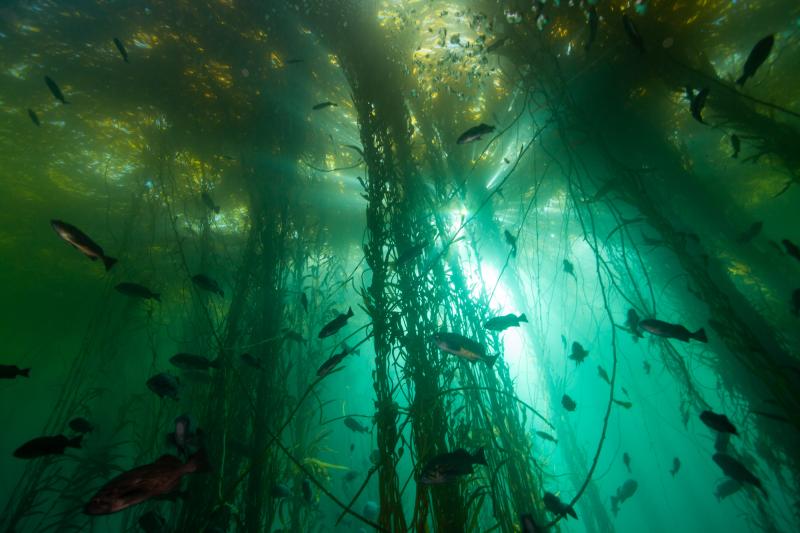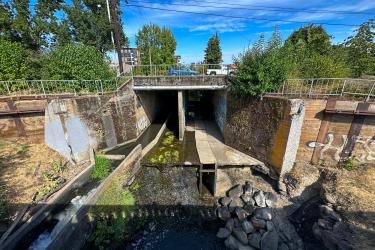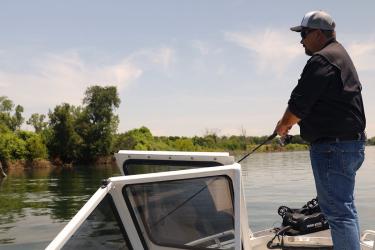Bull kelp forests, one of Earth’s most productive and biodiverse habitats, are in decline globally. Off the coast of Northern California, NOAA and the Greater Farallones Association are embarking on a critical mission to restore bull kelp in the Greater Farallones National Marine Sanctuary. NOAA’s Office of Habitat Conservation awarded the Greater Farallones Association $4.9 million through the Bipartisan Infrastructure Law and Inflation Reduction Act for this effort.
Like coral reefs, or forests on land, kelp forests are self-sustaining ecosystems. Hundreds of marine species—including invertebrates, fish, and marine mammals—find food and shelter within kelp forests’ towering stems and dark canopy. Kelp also captures carbon—up to 20 times more than terrestrial forests—making it a crucial player in the fight against climate change.
However, over the last decade, marine heat waves and a surging population of hungry purple sea urchins decimated bull kelp forests. They were reduced by up to 80 percent in some areas within Greater Farallones National Marine Sanctuary. As the forests disappeared, so did many of the animals that live in them. Fisheries worth tens of millions of dollars collapsed, cutting off an important source of income for local communities.
Now, following years of research, a team of scientists and restoration practitioners will begin to restore kelp at three locations in the Sanctuary. They will:
- Conduct research to advance kelp restoration techniques
- Remove thousands of pounds of purple sea urchins to create an oasis for kelp
- Restore up to 27 acres of kelp forest at locations with a high potential for recovery
- Support local jobs for commercial urchin divers and other small businesses
The Greater Farallones Association will carry out the work in partnership with Greater Farallones National Marine Sanctuary and other collaborators.
"I think for a long time a lot of folks didn't realize how important kelp forests are until we lost them," says Rietta Hohman, Kelp Restoration Project Manager for the Greater Farallones Association and Greater Farallones and Cordell Bank National Marine Sanctuaries as a NOAA affiliate. "This loss has reverberated through the local communities and tribes who hold the kelp forests in great cultural significance. Finally being able to take steps towards recovery is amazing, even if it’s going to take a while before we see robust results."
The Decline of the Sequoias of the Sea
Bull kelp attaches to the sea floor with a holdfast, growing up to 100 feet tall. Near the surface, a single gas-filled bulb sprouts up to 60 golden brown blades that sway with the currents like a mermaid’s hair. Invertebrates such as crabs and red abalone live between the stalks on the seafloor; juvenile rockfish and other commercial fish gobble up the forests’ abundant zooplankton. Seals hunt for prey among the kelp, or hide from bigger predators like great white sharks.
Beginning in 2013, a cluster of calamities wiped out more than 90 percent of California’s kelp in some regions. A mysterious tissue-wasting disease caused mass die-offs of sea stars along the West Coast. This included the sunflower sea star, which eats purple sea urchins, a common algae-eating inhabitant of kelp forests. The urchins, normally passive grazers, began chewing the kelp stalks all the way down to the holdfast. Over the next few years, a series of persistent marine heat waves combined with El Niño effects disrupted the kelp’s ability to reproduce.
While the kelp disappeared, the purple urchins persisted. “When there’s no food, the urchins go into a kind of hibernation,” says NOAA Habitat Restoration Specialist Natalie Cosentino-Manning, who has supported kelp restoration projects since 2002. “When a nutrient source like kelp becomes available again, they awaken and continue to consume and reproduce. It's kind of a losing battle with them in place.”
The ravenous purple urchins have also impacted other algae-eating species like red abalone and red sea urchins—both prized by seafood lovers. The recreational red abalone fishery closed in 2017, causing an estimated annual loss of $44 million. The red urchin fishery, worth an annual $3 million in commercial landings, also collapsed.
“Between 2007 and 2014, red sea urchins were 90 percent of my income,” says urchin diver Erik Owen, a Bodega Bay resident who first got his urchin permit in 1986. “Since 2015, I haven't made any income at all from red sea urchins.”
Creating a Plan for Restoring Kelp
In 2018, the Greater Farallones Sanctuary Advisory Council formed the Kelp Recovery Working Group, a collaborative team of researchers, nonprofits, tribal representatives, stakeholders, and resource managers. They work to address the severe loss of kelp forests in northern California. The recommendations from this Working Group were adopted by the Sanctuary Advisory Council and forwarded to the Superintendent. In 2019, Rietta Hohman led the development of the Sonoma-Mendocino Bull Kelp Restoration Plan for the Greater Farallones Association.
With funds and technical support provided by the NOAA Office of Habitat Conservation, Hohman hopes to begin kelp restoration this summer at three locations in the Sanctuary.
But first, the project team must keep the urchin population in check. After testing a variety of urchin removal techniques, they decided to use commercial urchin divers to harvest the urchins by hand.
Local Fishing Industry Joins the Effort
“Commercial urchin divers can remove hundreds and hundreds of pounds of urchins every single day,” says Hohman. “They're super-efficient and there's minimal impact to the reef.”
“Rietta approached me a couple years ago to talk about removing purple urchins,” says Owen, the urchin diver, who had taken up crabbing and salmon fishing to earn a living. “When California banned salmon fishing for the 2023 season, I started picking up interest in the purples. From September 9 to November 3, I took 17,000 pounds of urchins from Timber Cove (one of the restoration sites). The project gave me a job for the fall, and we made a big difference, getting 90 percent of the urchins out of that area. I hope to fire up again in April and be able to dive almost daily.”
Currently, the urchins are offloaded and taken to a compost facility by the Dandy Fish Company in Bodega Bay. “This work is a win from a business perspective and from the perspective of helping out the ecosystem,” says Rachel Thomsson, Dandy Fish Co-Owner. “In the last few years, with all of the challenges facing the fishing industry, we have seen a lot of fishermen go out of business. This type of collaboration with the Greater Farallones Association and NOAA is a beautiful way to use the fisherman’s skills and expertise. It’s breathing life back into the community. Fishermen want to sustain the ocean as much as environmental groups do. We all get it.”
Other stakeholders hope to turn the purple urchins into a seafood delicacy. The starved urchins would need to be fattened up with other seaweed in land-based urchin “ranches'' before becoming palatable.
Testing New Planting Techniques
With the field of kelp restoration still in its infancy, the team is testing different kelp planting techniques to see which will be most successful in the sanctuary. They contracted with Moss Landing Marine Lab and Sonoma State University to develop three practical and cost-effective techniques for planting kelp.
The first method involves gluing 3-by-3 inch concrete blocks with lab-cultured seedlings to the reef. Two other less-cumbersome techniques include planting mesh bags filled with kelp spore, and growing sporophytes (an early phase of the kelp life cycle) on twine and anchoring them to the seafloor.
“We learned a ton from our plantings in 2023 and also from our partners,” says Hohman. “We're hoping to have a nice long field season this year to address some of our unanswered research questions.” Divers from NOAA, the Greater Farallones Association, and other partners will carry out the plantings.
Further up the coastline, another NOAA-funded project will help the Kashia Band of Pomo Indians restore culturally important red abalone and to protect kelp by removing purple sea urchins.
Global Benefits of Local Restoration
Data collected during the project will guide restoration efforts by helping researchers understand what environmental variables may influence kelp settlement and survival. At each restoration site, scientists will deploy buoys with environmental sensors to monitor ocean conditions and use drones to map the surrounding areas. “Everything we learn is new and innovative,” says Hohman. “It's something that we hope can be applied to other areas with kelp loss around the world.”
According to Maria Brown¸ Superintendent of Greater Farallones and Cordell Bank National Marine Sanctuaries, restoring kelp forests has benefits beyond the local ecosystem. “Kelp is a form of blue carbon,” says Brown. “Kelp captures carbon, like a plant on land, into its structure. When they die, a portion of that kelp sinks to the seafloor and is buried. The captured carbon is then stored for up to thousands of years.”
A 2023 study shows that global kelp and seaweed forests offer a significant tool to mitigate climate change impacts when measures to conserve, restore and improve management are pursued in these habitats. Supporting kelp restoration efforts might help slow down the effects of climate change.
Once a baby bull kelp survives its early life stages and secures itself to seafloor, it can grow an astounding 10 inches per day. It reaches maturity within a year. Given the opportunity to grow unharmed and reproduce, this resilient species could have the chance to share its bounty with the ecosystem and people again.







